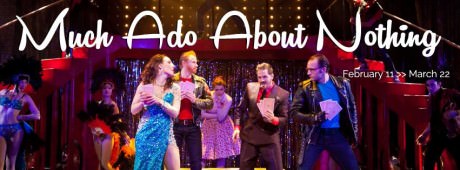Synetic Theater’s terrific “silent” production of Shakespeare’s Much Ado About Nothing had me wondering about the many technical design element decisions made long before an audience stepped into the Crystal City theater space.

How did the folks at Synetic go from words on a printed page (or perhaps these days, pixels viewed on a screen) to such a physical, athletic, joyful, fun, sometimes understandably deeply dark, and oh so nuanced “silent” production?
It is clear to me that early, and unknown to me, technical decisions were critical to such a critically and audience acclaimed production.
So with my curiosity stoked, I asked Paata Tsikurishvili, Synetic’s Founding Artistic Director, and Nathan Weinberger, co-adaptor, of Much Ado About Nothing, to chat about some of the early technical design issues for Synetic’s production.
David Siegel: What were the special challenges in adapting and producing Much Ado About Nothing, a play so full of language about trickery and comedy?
Paata and Nathan: That was our very first question: How do we translate the soul of the play–the verbal banter–into physicality? That led us to the root question of, “What really IS banter and verbal back-and-forth in the first place?” It’s competition; it’s a game. This is part of why we set the play in a casino–a place of competition and games (friendly and not-so-friendly), and this opened up a whole new channel of how to stage Benedick and Beatrice’s own banter and competition.
Please build on your director’s notes regarding locating the play in 1950s Las Vegas. Were other time periods and locales considered and then discarded?

There were a number of times and places considered. The British Raj, Colonial America–these were all dramaturgically sound, but we ultimately decided on the 50’s Vegas because of the movement opportunities it afforded us, which I described above–opportunities that allowed us to cover the most bases, to give you something really eye-catching and unforgettable as well as doing the most justice to the original text.
How did Synetic decide what scenes and relationships from Much Ado About Nothing’s written text to emphasize in its two act, silent production?
The process for deciding what scenes to include–where to consolidate, where to make cuts, where to put the dramatic (or comedic) emphasis, and so on–this process is the same as in any other staging of Shakespeare. I think there’s a misconception out there that what we do is somehow completely foreign to the plays–to even the spirit of the plays. But these stories, like energy, never really go away; they simply change form and modality–specifically, in our case, by being recommunicated in a non-traditional manner, just as Prokofiev re-communicated Romeo and Juliet with ballet and Verdi re-communicated Othello with music, and on and on.
What was the the artistic collaboration work between the adapter, director, choreographer, and the music composer?
This was one of those cases–though they seem to be getting more and more frequent for us!–where the whole team was on the same page, excited, on-board, and working together to achieve the same goal from Day One. Once the concept was suggested and settled on, I think we pretty much all had the same vision for it. From there, one idea simply built on another, enhancing the original concept more and more—so I would say the teamwork between all of us (dramaturgy/adaptation, choreography, composing) on this one played like a symphony. It was just fun, pure and simple. Hopefully, our audiences see and feel that way with our final product.
At what point in the process did the music composition begin for Much Ado?
There were a lot of copyright questions floating around during rehearsal–“Can we use this? Should we start writing letters to estates?”–but in the end, I think we used everything–or our own versions of everything–that we wanted. But the process of choosing and working with the music–that began before the first day of rehearsal and continued throughout, evolving with the production, often directly influencing the production’s evolution and growth. It really can’t be any other way, since (especially for our silent productions), the music is the show’s “second script”, so to speak–as important and influential as any text (or movement tracks) written down for the actors to memorize.
For the artistic collaboration between the choreography/movement design ideas and the music composition -does one come before the other?

They evolve together, and start on the same day. Sometimes, the choreography influences the music, and sometimes it’s the other way around. But however it may happen on a given day, it’s an entirely collaborative and complimentary process.
How long was the rehearsal process for Much Ado? Was this time similar for the previous ten Shakespeare adaptations?
The rehearsal time for this was around three months, about the same as for all of our Silent Shakespeares. It’s a long process, but it’s how it has to be, to achieve the necessary precision and detail to make all this work.
The Synetic production of Much Adohas a rich mosaic of actors. Beyond physical movement abilities – what other attributes did you seek?
Very simple: Comedic skills. Clowning ability. And I’m very pleased to say that I think I got very lucky on this one, in that I think I found those skills to spare in this remarkable cast: As with Twelfth Night, I’m hearing comparisons of my actors to Chaplin, to Keaton and that’s immensely gratifying.
Much Ado About Nothing plays through March 22, 2015 at Synetic Theater – 1800 South Bell Street, in Arlington, Virginia. For tickets, purchase them at the door, call the Box Office at (866) 811-4111, or buy them online.
LINKS
Review of Much Ado About Nothing on DCMetroTheaterArts





